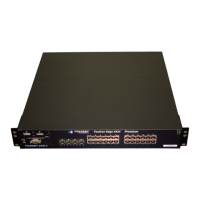Foundry Configuration Guide for the FESX, FSX, and FWSX
6 - 8 © Foundry Networks, Inc. December 2005
class of 0 (15.4 watts) will receive a maximum of 12.95 watts of power after 2.45 watts of power loss through
the cable. This is compliant with the IEEE 802.3af specification for delivering in-line power. Devices that are
configured to receive less POE power, for example, class 1 devices (4.0 watts), will experience a lower rate of
power loss through the cable.
• The CLI commands for this feature differ on the FSX POE compared to the FES POE. On the FES POE,
there are separate CLI commands for 802.3af-compliant versus 802.3-af non-compliant power consuming
devices. On the FSX, there is one command for all power consuming devices. The command syntax is also
different on the FSX.
Command Syntax
To configure the power class for a POE power consuming device, enter commands such as the following:
FastIron SuperX Switch# config t
FastIron SuperX Switch(config)# interface e 1/1
FastIron SuperX Switch(config-if-e1000-1/1)# inline power power-by-class 2
These commands enable in-line power on interface e 1 in slot 1 and set the power class to 2.
Syntax: inline power power-by-class <class value>
where <class value> is the power class. Enter a value from 0 – 3. See Table 6.3 for the power classes and their
respective maximum power allocations. The default is 0 (15.4 watts).
For information about resetting the power class, see “Resetting POE Parameters” on page 6-9.
Setting the In-line Power Priority for a POE Port
Each FSX POE (48V) power supply provides a maximum of 1080 watts of power, and each POE port receives a
default maximum value of 15.4 watts of power, minus any power loss through the cable. The power capacity of
one or two POE power supplies is shared among all POE power consuming devices attached to the FSX POE.
In a configuration where POE power consuming devices collectively have a greater demand for power than the
POE power supply or supplies can provide, the FSX must place the POE ports that it cannot power in standby or
denied mode (waiting for power) until the available power increases. The available power increases when one or
more POE ports are powered down, or, if applicable, when an additional POE power supply is installed in the FSX.
When POE ports are in standby or denied mode (waiting for power) and the FSX receives additional power
resources, by default, the FSX will allocate newly available power to the standby ports in ascending order, by slot
number then by port number, provided enough power is available for the ports. For example, POE port 1/11
should receive power before POE port 2/1. However, if POE port 1/11 needs 12 watts of power and POE port 2/1
needs 10 watts of power, and 11 watts of power become available on the device, the FSX will allocate the power to
port 2/1 since it does not have sufficient power for port 1/11.
You can configure an in-line power priority on POE ports, whereby ports with a higher in-line power priority will
take precedence over ports with a low in-line power priority. For example, if a new POE port comes on-line and
the port is configured with a high priority, if necessary (if power is already fully allocated to power consuming
devices), the FSX will remove power from a POE port or ports that have a lower priority and allocate the power to
the POE port that has the higher value.
Ports that are configured with the same in-line power priority are given precedence based on the slot number and
port number in ascending order, provided enough power is available for the port. For example, if both POE port 1/
2 and POE port 2/1 have a high in-line power priority value, POE port 1/2 will receive power before POE port 2/1.
However, if POE port 1/2 needs 12 watts of power and POE port 2/1 needs 10 watts of power, and 11 watts of
power become available on the device, the FSX will allocate the power to POE port 2/1 since it does not have
sufficient power for port 1/2. By default, all ports are configured with a low in-line power priority.

